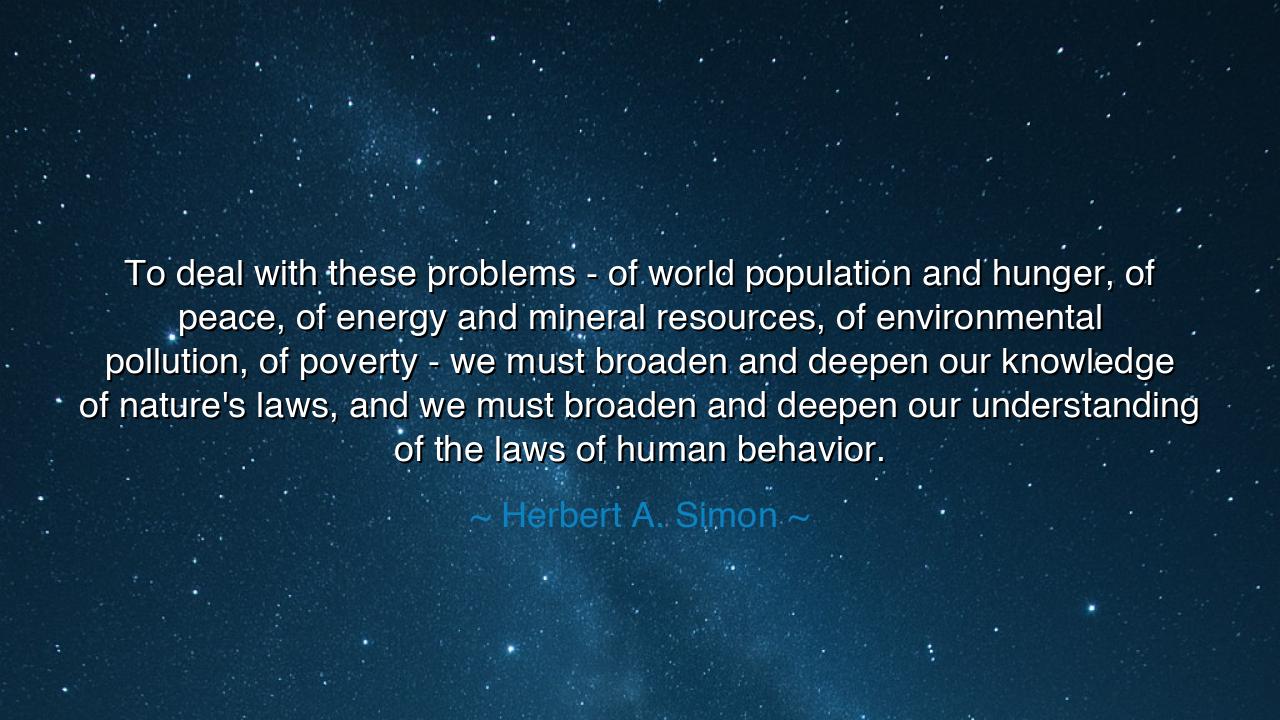
To deal with these problems - of world population and hunger, of
To deal with these problems - of world population and hunger, of peace, of energy and mineral resources, of environmental pollution, of poverty - we must broaden and deepen our knowledge of nature's laws, and we must broaden and deepen our understanding of the laws of human behavior.






In the councils of wisdom, the elders taught that a house is secured by two pillars or it falls upon its sleepers. Herbert A. Simon names those pillars with rare clarity: to face the tempests of world population and hunger, of peace, of energy and mineral resources, of environmental pollution, of poverty, we must broaden and deepen our knowledge of nature’s laws, and just as surely broaden and deepen our understanding of the laws of human behavior. One pillar without the other is vanity: to know the rivers yet not the hearts that dam them, or to know the hearts yet not the rivers that sustain them. Wisdom, like a bridge over a chasm, must be anchored on both shores.
The first pillar is the grammar of creation—the steady commandments of thermodynamics and ecology, epidemiology and agronomy, the quiet arithmetic by which soils recover, oceans circulate, forests breathe, and climates find their temper. Here we learn that crops obey seasons; that energy cannot be conjured without cost; that pollution is not a rumor but a ledger written in lungs and reefs. To broaden and deepen our knowledge of nature’s laws is to apprentice ourselves to limits and to possibilities; to become translators of rain, root, and rock so that our plans do not quarrel with reality.
The second pillar is the choreography of the human crowd—customs and incentives, fear and hope, bargaining and trust. Here we learn that people do not move like particles; they braid stories, imitate neighbors, defend status, hoard when frightened, share when belonging. To broaden and deepen our understanding of the laws of human behavior is to accept that policy without psychology is a blunt blade, and that institutions must be designed as carefully as engines, with feedbacks, guardrails, and dignity built in.
Consider a story from our own age that fuses both pillars into one arch: the healing of the ozone layer. Chemists traced a wound in the sky to chlorofluorocarbons—knowledge of nature’s laws revealing how a simple molecule unstitched stratospheric ozone under polar sun. But science alone could not lift the burden. Nations bargained, industries retooled, incentives were aligned, and a treaty—the Montreal Protocol—turned discovery into discipline. This was understanding human behavior made law: compensation for those who would lose, deadlines with teeth, monitoring that built trust. The sky began to mend because chemistry and cooperation walked together.
Now set beside it a cautionary tale. Many a city has built glittering desalination plants to answer water scarcity—machines that obey physics impeccably—while ignoring the social currents that decide who pays, who saves, who wastes, who repairs. Where prices insult the poor, leaks fester; where governance is opaque, maintenance withers; where education is scorned, conservation never takes root. The pumps hum, and still the taps run dry. Nature was consulted; human nature was not. And so the cure, though engineered well, failed its patient.
From Simon’s saying, take a law for all great labors: diagnose with two eyes. When facing environmental pollution, ask not only “What toxin and what filter?” but “What habit and what incentive?” When seeking peace, measure not only borders and weapons but honor, grievance, and fear. When confronting poverty, count not only coins and calories but power, agency, and belonging. The world yields to those who can read its atoms and its allegiances at once.
Let counsel become craft. Build schools and guilds where engineers dine with sociologists; where agronomists walk fields with anthropologists; where public-health nurses learn game theory and modelers learn humility at a clinic bench. In your own circle, practice the twin apprenticeships: keep a notebook for the phenomena you observe—rainfall, prices, electricity use—and another for the behaviors you witness—cooperation, delay, rumor, pride. Design small experiments that honor both: a clean stove that fits fuel and custom; a savings program that fits cash flow and culture; an energy tariff that fits watts and wages. In this way, you will broaden and deepen the only knowledge that endures: how the world works, and how we do.
Finally, teach the young this creed in plain words: “Learn the river and the rower.” For the crises named—world population, hunger, peace, energy and mineral resources, environmental pollution, poverty—are not dragons slain by a single sword. They are knots loosened by patient fingers trained in physics and fellowship, in data and dignity. Walk this path, and your works will carry the weight of the real; your policies will fit both climate and character; and your generation will hand to the next not just tools, but the wisdom to wield them.






AAdministratorAdministrator
Welcome, honored guests. Please leave a comment, we will respond soon